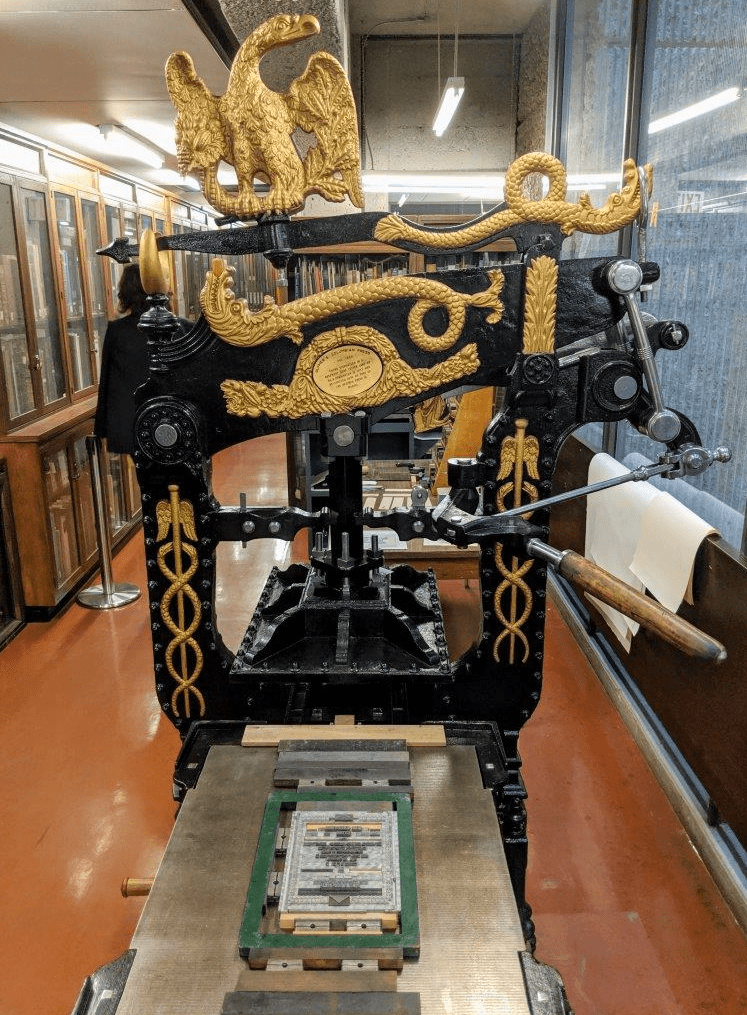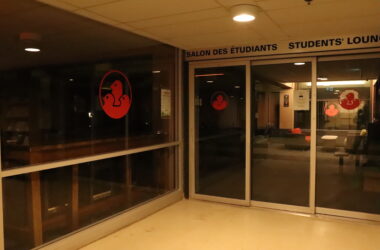Patrons of McGill’s Rare and Special Collections, Osler, Art, and Archives (ROAAr) filled the fourth floor of the McLennan Library Building on Jan. 30 for the unveiling and demonstration of the earliest surviving Columbian printing press in North America. The event also launched the library’s Book Arts Laboratory, which will use the press as an educational tool for several faculties across the university.
McGill’s printing press, first invented by George Clymer of Philadelphia in 1813, is the earliest surviving model of a Columbian press in North America. The library’s copy was manufactured in England in 1821 and obtained by McGill in 1958: The principal and director of libraries at the time, Cyril James and Richard Pennington respectively, spearheaded the printing press’ acquisition.
Now that it has been renovated, the reveal was the first in a series that will focus on the press itself held in the Book Arts Lab.
“The press was gathering dust in the library’s basement until [the library received a grant] a few years ago allowing the press to be restored,” Book Arts Lab librarian Lauren Williams said.
The press operated at McGill from 1957 through 1965, and was integrated as a part of McGill’s teaching program, until the library put it in storage in the 1970s.
“It has been almost 50 years since [the press] has been functional, [and] this is what we’re celebrating today,” ROAAr librarian Anne Marie Holland said. “It is [a part of McGill’s] William Colgate History of Printing Collection […] one of the largest subject specific collections [in North America] and a practical, rich universe for the study of the history of books and print culture in general.”
Professor Eli MacLaren of McGill’s English department, whose teaching focusses on Canadian literature and poetry, spoke next. MacLaren discussed how our understanding of the power of books can influence how we learn not only about literature, but also about other cultures.
“Seeing how books are made, preferably with a glass of red wine in hand […] is really a priceless way to begin to discover what [books] mean and what they have meant at different times and places,” MacLaren said.
Speeches were followed by a demonstration of the printing press, led by Jennifer Garland and Williams, two of the Book Arts Laboratory librarians. The hosts allowed guests to handle the press themselves and create a print with details of the event.
“It’s so easy to use,” Garland said. “But it is literally back-breaking work!”
Restored to its black and gold gilt colours, the press was shiny and ornate, with a large sculpture of an eagle sitting atop one of the main levers, moving with the lever as it is pulled. This design was very distinctive during the 19th century, and was often known as the ‘eagle press’ by those working in the printing industry. Operating thanks to a weighted lever system, the press applies an enormous amount of pressure, making it easier for those pulling the lever to create numerous copies of a design.
With plans to use the press for many events in the upcoming Winter 2020 semester, the lab has been equipped with a number of primary type supplies in order to truly promote the usage of the press. Through these actions, the ROAAr hopes to educate both students and staff on the importance of such historic literary tools, creating a unique interactive learning opportunity.
“Using primary sources to show and not tell is the hallmark of any great university,” MacLaren said. “Hopefully, this press will do just that.”









